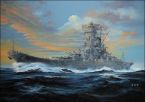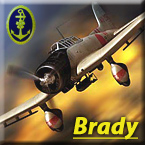SuluSea
Posts: 2358
Joined: 11/17/2006
Status: offline

|
quote:
ORIGINAL: FatR
quote:
ORIGINAL: SuluSea
I guess it depends on the definition of a "major or active base".
I see goal posts starting to move here.
I'll move on knowing the Allies not only contiplated but carried out successful unescorted bombing attacks against fighter opposition long before the B-29.
Well, then you surely can provide, you know, actual examples? And, as you're concerned about goalposts, these attacks should actually be a)against fighter opposition, i.e., engaged by fighters; and b)successful, i.e. with noticeable damage to the enemy.
Shall I tell you whether they wore boxers or briefs as well?

In addition to the other examples I posted.
quote:
The next offensive mission came on 25 January 1943, when six B-24's of the 371st Bombardment Squadron staged through Midway for daylight reconnaissance and incidental bombing of Wake. The bombers flushed six to eight interceptors, but their reaction was tardy and the damage to the heavies slight.17 Again, on 15 May, seven out of eighteen planes dispatched by the 371st and 372d Squadrons struck Wake during daylight. The enemy intercepted with nineteen Zekes and three Hamps, trading four of the interceptors for a B-24, the first B-24 lost to enemy action by the Seventh Air Force.18 Finally, on 24 and 26 July the reconstituted 11th Group, now flying B-24's, sent two missions of squadron strength against the former American outpost. Diversionary in nature, these attacks had been ordered by the Navy in the hope of confusing the enemy as to our intentions in the Pacific. Japanese defenses seemed to have been greatly improved, but the returning crews claimed a total of twenty interceptors destroyed. One B-24 had crashed into the ocean after a mid-air collision with an enemy fighter falling out of control.19 Wake would not be hit again by the Seventh Air Force until March 1944. These early raids, though small and scattered, had been generally well executed and effective.20
quote:
By staging down through Funafuti in the Ellice Islands, for a total distance of well over 2,000 miles via Canton, Palmyra, or Christmas Islands, it had also been possible to strike twice against enemy positions in the Gilberts during April 1943. After the Japanese had seized the Gilberts early in 1942, they had constructed a two-strip airfield and elaborate fortifications on Tarawa. In addition, they had occupied Apamama and Makin and the outlying atoll of Nauru, to the west. These atolls carried a potential threat to the Allied line of communications joining the South and Central Pacific, and as with the coming of 1943 the Joint Chiefs of Staff gave some thought to the possibility of a Central Pacific offensive,* the islands acquired a new importance. After sending two reconnaissance missions in small force over the Gilberts in January and one in February,21 General Hale got the green light from Admiral Nimitz for a quick one-two jab at Tarawa and Nauru. Nimitz designated for the mission the 371st and 372d Bombardment Squadrons, joining them together as Task Force 12 under the personal command of General Hale. Reconnaissance of all the Gilberts, for the purpose of determining the airfield potentials for either Japan or the Allies, was to be combined with the bomber strikes. The task force would return from its temporary base at Funafuti upon completion of its mission.22
Having dispatched a small boat two weeks in advance with necessary supplies and equipment, General Hale reached Funafuti with the B-24's on 18 April. Two days later at high noon twenty-two of the B-24's droned over Nauru. Since an early morning take-off, they had carried their bomb loads more than a thousand miles, which crowded the tactical radius of the B-24D to the limit. The weather over the target was excellent for the bombing with 28 x 1,000-pound and 45 x 500-pound GP bombs plus 45 frag clusters. Despite heavy interception and antiaircraft fire, direct hits on the runway, dispersal area, and a near-by phosphate plant were achieved. An oil dump at the north end of the runway went up in flames.23 General Hale, who had gone on the mission, returned to Funafuti in high spirits over the performance of his inexperienced crews. The heavy damage sustained by five of the B-24's forced postponement of the Tarawa strike, originally scheduled for the 21st. As it happened, this delay proved fortunate, for the enemy promptly struck back in a predawn raid on the strip at Funafuti that would have caught the American bombers just as they assembled for the take-off. Even so, the B-24's parked along the narrow runway suffered serious damage when a hit on a bomb-loaded plane resulted in its destruction and in damage to five other planes.24
quote:
The transition to B-24's for all Pacific heavy bombardment units, a transition begun late in 1942, greatly enhanced the importance of modification as a depot function. The B-24D was sadly lacking in firepower, particularly in the nose of the plane. Japanese pilots soon discovered this defensive weakness, with the result that General Landon reported that approximately half of all early enemy fighter attacks on B-24's were made front ally.37 After Lt. Col. Marion D. Unruh, of the VII Bomber Command, had designed a nose turret to correct the weakness,* it was installed by the Hawaiian Air Depot in more than 200 B-24's during 1943.
quote:
1 February 1944. CATCHPOLE, as operations for the occupation of Eniwetok Atoll had been coded, would take place three months later.100 The ease with which Kwajalein and Majuro were occupied, however, prompted a speed-up in timing which resulted in a decision to mount CATCHPOLE immediately, and by 19 February, Eniwetok, northwesternmost of the Marshalls, also had been captured against light enemy resistance.
So far as air operations were concerned, the campaigns in the Gilberts and Marshalls were continuous. On 21 November 1943 (D plus 1 on Tarawa), B-24's of the 38th Bombardment Squadron escorted Navy PB4Y photo planes over Nauru, while Liberators of the 431st and 42d Bombardment Squadrons conducted daylight bombing raids on the same target.101 During the remainder of November and most of December, Seventh Air Force Liberators, staging through Baker and Nanomea from their bases at Canton and in the Ellices, continued to pound Nauru, Mille, Jaluit, and Maloelap, in tactical support of the base-development phase of GALVANIC and in preparation for CATCHPOLE. Beginning on 16 December, Wotje, site of a strongly fortified and well-defended airfield and extensive seaplane facilities, came under the sights of the B-24's.102
It's kind of humorous reading complaints against the allied side knowing how many ahistorical bonuses Japan gets.
I believe the developers got this aspect correct. Just like players of the Japanese side train their pilots up allied players are training as well.
_____________________________
"There’s no such thing as a bitter person who keeps the bitterness to himself.” ~ Erwin Lutzer
|
 Printable Version
Printable Version
























 New Messages
New Messages No New Messages
No New Messages Hot Topic w/ New Messages
Hot Topic w/ New Messages Hot Topic w/o New Messages
Hot Topic w/o New Messages Locked w/ New Messages
Locked w/ New Messages Locked w/o New Messages
Locked w/o New Messages Post New Thread
Post New Thread